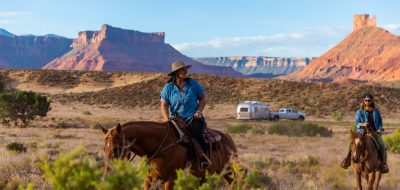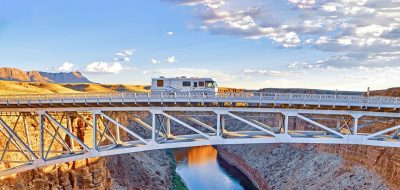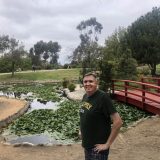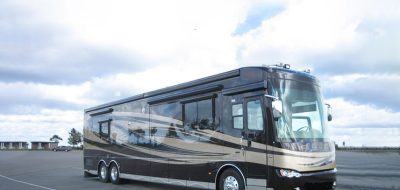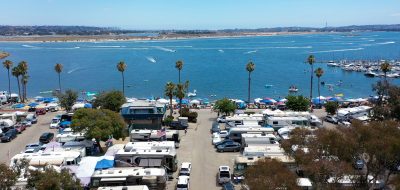Weather alert: “A heat warning for daily high temperatures above 100 degrees has been extended for all desert areas.”
 Load up the recreational vehicle and escape the scorching summer temperatures with a road trip to the cool mountain air of southwestern Utah.
Load up the recreational vehicle and escape the scorching summer temperatures with a road trip to the cool mountain air of southwestern Utah.
Utah’s Patchwork Parkway (Scenic Byway 143) beckons travelers to enjoy a change of scenery and a drop in temperature. This scenic byway serves as the western gateway from the arid Great Basin of western Utah to a breathtaking route across Utah’s high plateaus, connecting to Heritage Highway 89 and Scenic Byway 12, Utah’s first All American Road.
This dramatic 55-mile scenic course links the historic pioneer communities of Parowan and Panguitch where early Mormon pioneer settlement and culture abound and follows a course over the Markagunt Plateau. The entire original Panguitch town site is listed on the National Register of Historic Places.
This byway weaves through a patchwork of geologic formations, forests, streams, lakes, cultural sites, beautiful meadows, and diverse wildlife. Nearby major attractions include Bryce Canyon National Park and Zion National Park.
The historic community of Parowan is situated just off Interstate 15 and is the western gateway to access Patchwork Parkway. A charming small town with big history, Parowan is southwestern Utah’s oldest settlement and offers historic museums and markers related to the Native American and pioneer inhabitants of the region. Pioneer museums, an historic cemetery, and numerous historic sites are available for visitors.
 Enjoy the scenic 20 minute Sky Lift at Brian Head Resort. Take in breath-taking views from the lift as you glide to the top of Giant Steps. From there one can bike, hike, sit down, relax, and take in the views at 10,000 feet. The clear vantage point at the top presents stunning vistas of several mountain ranges, red rock, and clear mountain air. New in 2011 is a self-guided interpretive and activity course along the Dixie National Forest’s scenic Vista hiking trail.
Enjoy the scenic 20 minute Sky Lift at Brian Head Resort. Take in breath-taking views from the lift as you glide to the top of Giant Steps. From there one can bike, hike, sit down, relax, and take in the views at 10,000 feet. The clear vantage point at the top presents stunning vistas of several mountain ranges, red rock, and clear mountain air. New in 2011 is a self-guided interpretive and activity course along the Dixie National Forest’s scenic Vista hiking trail.
The Markagunt Plateau is a broad expanse of forest and open spaces. Alpine meadows offer astounding displays of wildflowers from early July until late summer.
On the topmost edge of this plateau you’ll find Cedar Breaks National Monument.
The 2,000-foot-deep Cedar Breaks amphitheater with its vibrant hues of pink, orange, red, and other coral colors is carved from the Claron Formation and spans three miles. Colored by the presence of iron and manganese oxide, this limestone Clarion formation is made up of intricate ridges, pinnacles, and buttresses. From sunrise to sunset, in blazing sun or cloudy periods, the rocks of Cedar Breaks display a rainbow of warm hues.
Very few routes in the U.S. exhibit a 4,500-foot elevation change that crosses six major life zones in 51 miles. On the east slope of the plateau, the route skirts lava flows only a few thousand years old before passing Panguitch Lake, a spectacular, large mountain lake renowned for its excellent fishing. The word Panguitch actually means ‘big fish’ in the Paiute language.

On the east slope of the plateau, the route skirts lava flows only a few thousand years old before passing Panguitch Lake, a spectacular, large mountain lake renowned for its excellent fishing. © Rex Vogel, all rights reserved
Panguitch town site is the eastern gateway to the Patchwork Parkway. During their first winter when pioneer settlers ran out of supplies, seven men were sent from Panguitch to Parowan for grain. They struggled to walk in the deep snows, but made better progress when they began to use their bedding, actual quilts, to walk on the snow. This event has been memorialized as the famous Quilt Walk and is the source of the name—The Patchwork Parkway. Such quilts are reminders of the patchwork of the byway’s unparalleled scenery, vibrant history, and natural beauty unequaled across the country.
Special Considerations
Parowan is at 5,990 feet; Brian Head Peak is 11,307 feet. The byway doesn’t climb quite that high, but it does climb to over 10,000 feet. Take precautions if you are not accustomed to high elevation.
Restrictions
Parts of the route have 13% grades and some sharp switchbacks. Large recreational vehicles are not recommended. In winter, the section of road from Parowan to Brian
Head Ski Resort is kept open; the rest is closed. Snow tires or chains are advised during winter months.
Best Time to Drive
Summer is the best time to drive the byway, since it is open in its entirety. Autumn allows travelers to experience historic sites in gateway communities and an astounding display of fall colors set against Cedar Breaks National Monument.
Worth Pondering…
The journey not the arrival matters.
—T. S. Eliot
